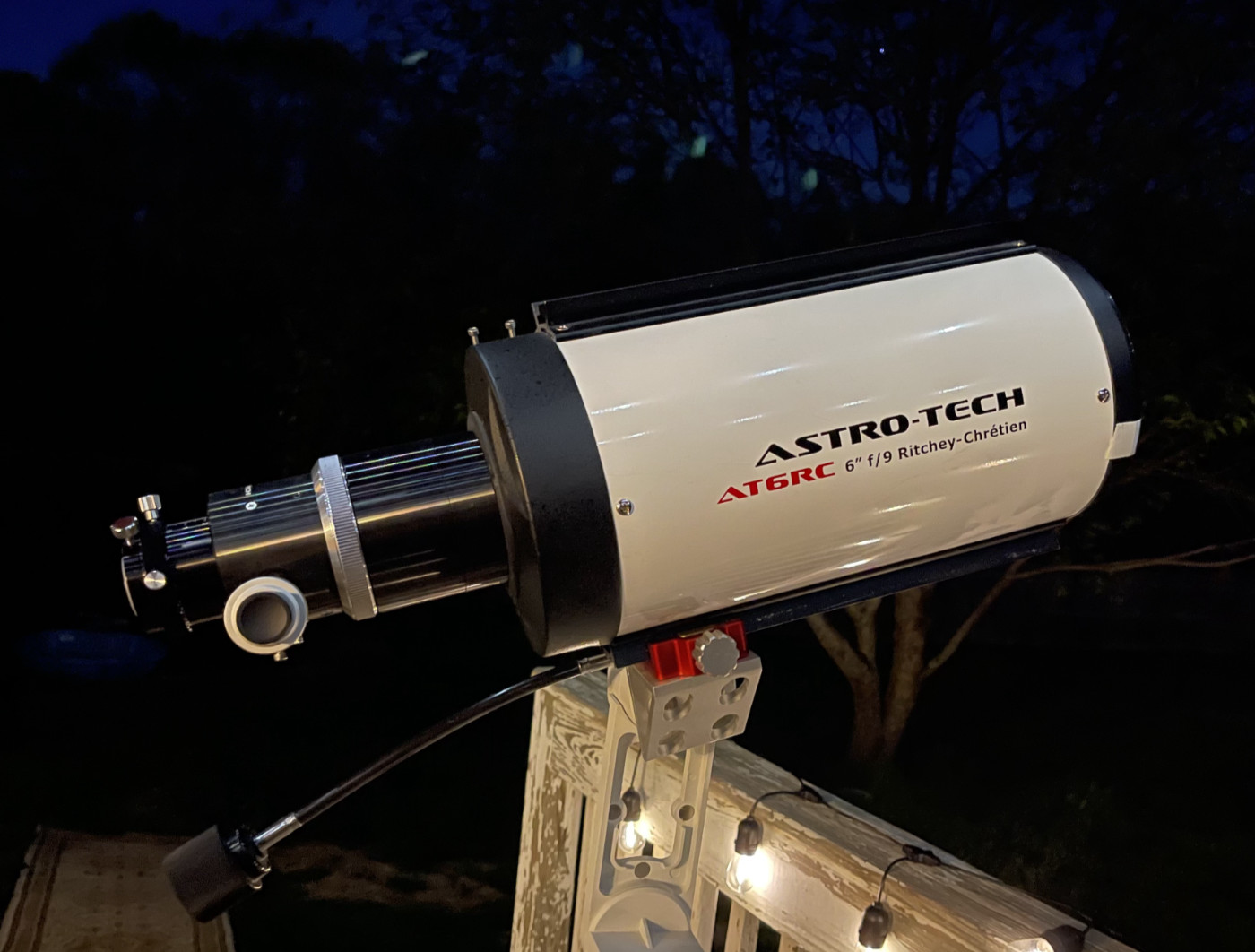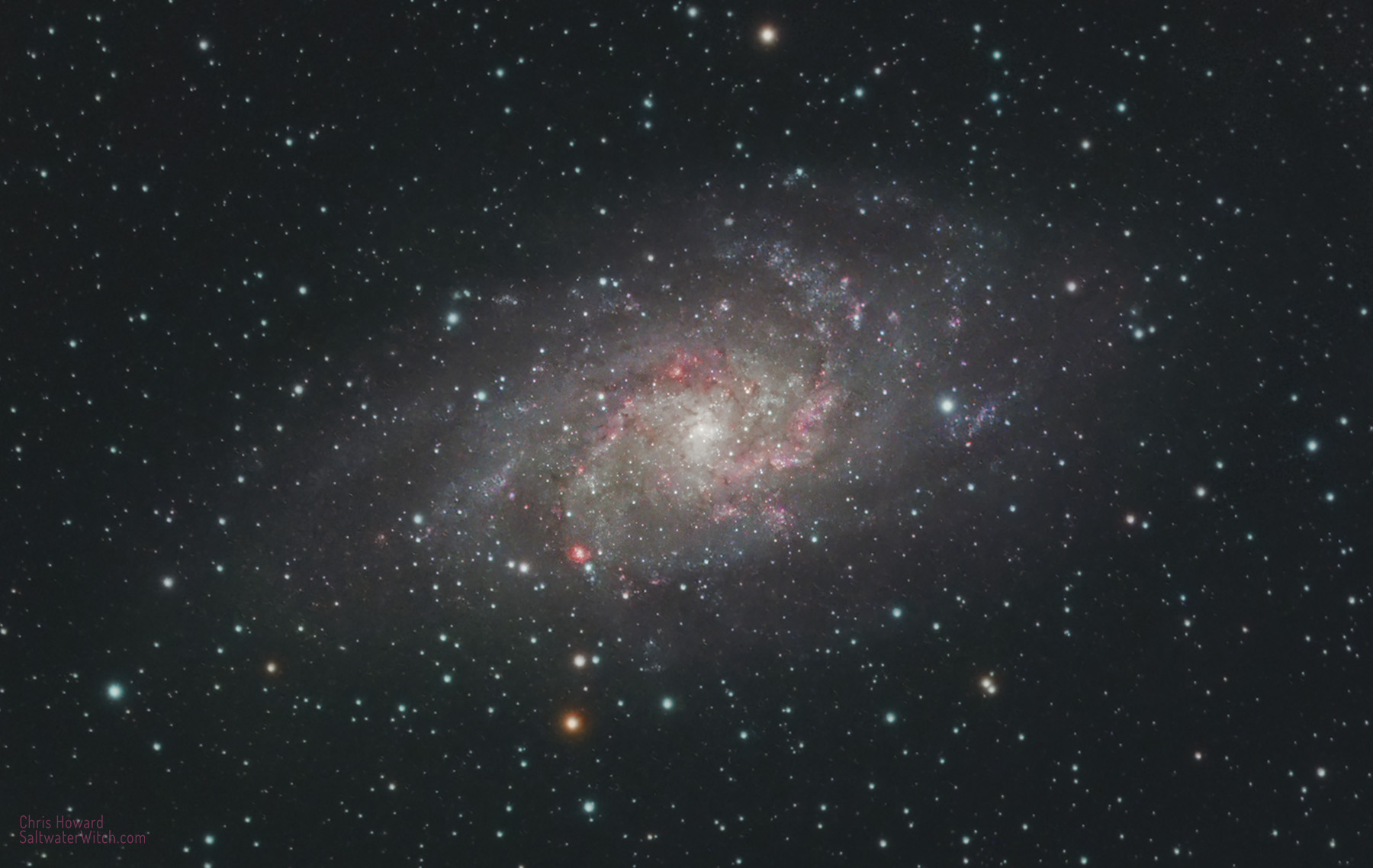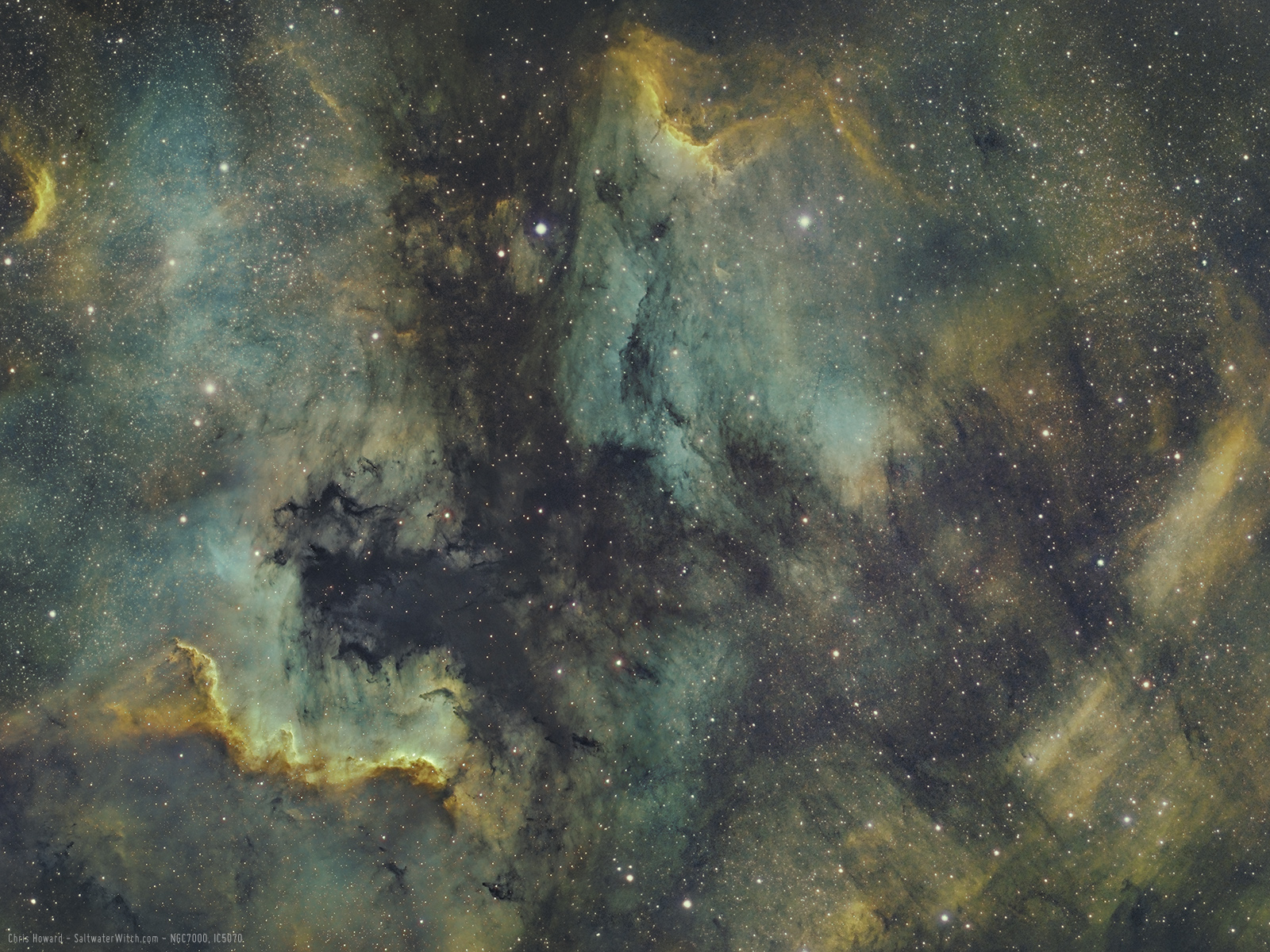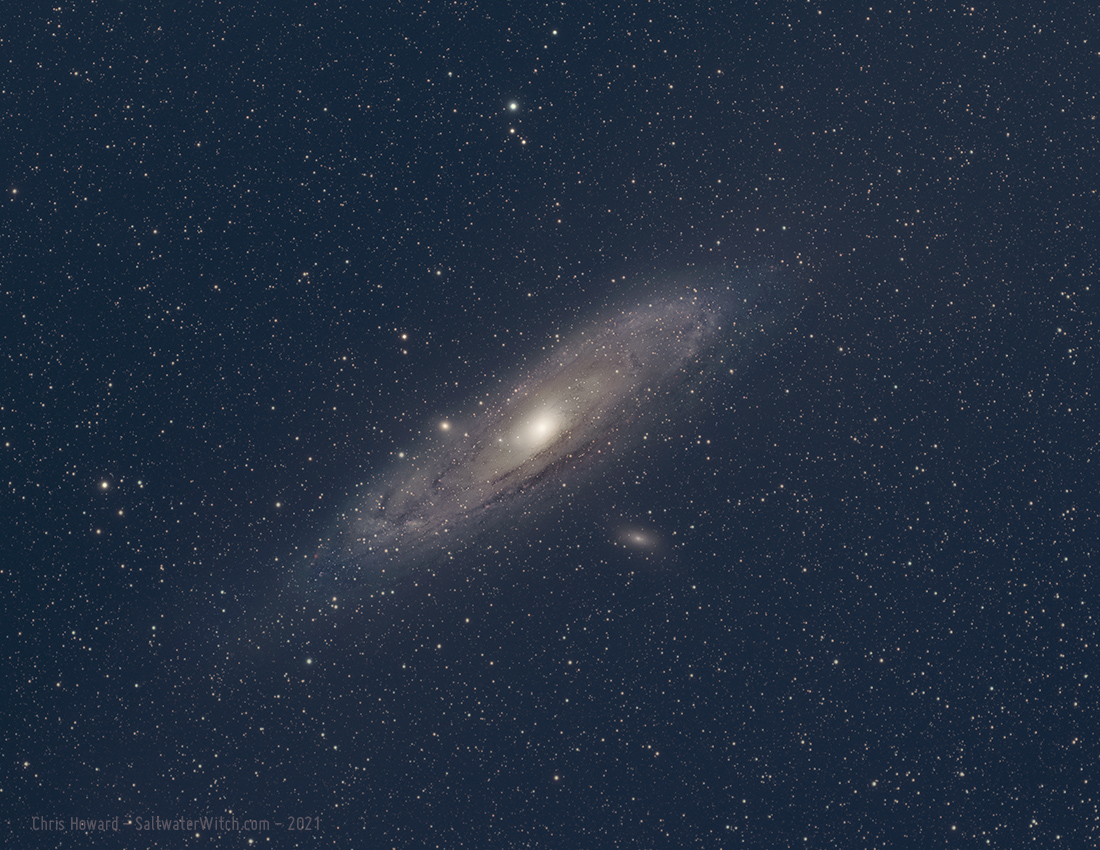Sony A7s Test with a Waxing Moon
There's a beautiful moon out there this evening! This is from my first set of test shots with my Sony A7s on the 1350mm f/9 Astro-Tech AT6RC.


[Update: I shot this with the Sony A7S on the Astro-Tech AT6RC 1350mm f/9 scope while preparing for the total lunar eclipse May 15-16th, 2022. Unfortunately, the clouds moved in a day after taking this and didn't leave until after the eclipse. So I missed the main event, but did get some pretty nice test shots. This is a single exposure, f/9, 1/60 sec at ISO 400 with the Sony Full-frame A7S]. Here we are around 9:15 pm, this time with the Celestron UHC/LPR Filter:

Here's the AT6RC scope:

Posted May 13, 2022
Narrowband "Flying Bat" Nebula in Ha (sans squid)
I finally started gathering Hydrogen-alpha data for the Flying Bat nebula (Sh2-129) in the constellation Cepheus. What you do not see in Ha is the large, squidlike structure of oxygen that stretches from the top corner of the Bat, through those bright stars, to about the middle of the nebula For the "Squid Nebula" (OU4) I need to come back on another night to capture the OIII. The small circular reflection nebula at the top left is vdB-140. The dark nebula on the right is Barnard 152.
Notes: 67 x 300 second subs, stacked in DSS. Gear: William Optics SpaceCat51 Apo Refractor, ZWO ASI1600MM-Pro mono camera, Antlia Pro 3nm Ha filter, Sky-Watcher EQ6R Pro equatorial mount.

Posted May 12, 2022
Triangulum Galaxy, Picking Favorites
M33, the Triangulum Galaxy in Ha+RGBColor with the SpaceCat51 and ZWO ASI071MC cooled color camera + Atik 414EX monochrome camera. I processed some 2018 and 2019 data to see what kind of detail I can get out NGC 604--that's the large pink mass at the middle bottom of the galaxy in this rotation. NGC 604 is a vast HII region, much brighter and 40 times larger than the Orion Nebula in our galaxy. M33 is a little under 3 million lightyears away.
Andromeda (M31) was the first deep sky object I captured with a camera--an old Nikon D40x DSLR. The Orion Nebula (M42) was the second. For many years M31 was my favorite galaxy and it is in many ways the ideal galaxy; it's a massive spiral at the perfect photographic angle from our perspective, here in the middle of our own galaxy. At two and a half million lightyears, it's not far away. And while M101, the Pinwheel Galaxy, is perfect from a galactic structure point of view, being a face-on from our perspective (or top down), Andromeda is cinematically posed for all of us taking pictures from earth. Galaxies are not really my thing. I usually focus on narrowband imaging of nebulae, supernova remnants, and other large structures within the Milky Way--so, thousands of lightyears away, not millions. I almost always shoot with sub-1000mm focal lengths, and galaxy imagers are usually running with 2000mm or more. OTAs of 3000mm and up are common.
Andromeda is certainly one of my favorites, but I think the Triangulum Galaxy (Messier 33, M33, NGC 598) in the constellation Triangulum is my favorite northern hemisphere galaxy. It's kind of chunky with vast HII regions (the pink structures scattered along the spiral arms). It gets a little thin out toward the edges; not the smooth plane of stars you see in the Andromeda galaxy. It's made up of 40 billion stars rather than the trillion or so in Andromeda. M33 is another galactic neighbor and close enough to capture with medium focal lengths.

Posted May 9, 2022
M13 - Hercules Globular Cluster
I was experimenting with UV/IR cut filters on the ZWO ASI071MC last night, and took a bunch of test subs without guiding--all 30 second exposures. This is 97 sub-exposures of M13 (NGC 6205) in the constellation Hercules. Messier 13, like most (all?) globular clusters orbit in the halo of the Milky Way galaxy, a good distance away from the core, both above and below the galactic plane.

And more stars (IC 4756 star cluster). More testing with the IR/UV cut filter and the ZWO ASI071MC camera.

Posted May 2, 2022
NGC 7000, IC 5070
North America Nebula (NGC 7000, left) and Pelican Nebula (IC 5070, top right) in the constellation Cygnus. Narrowband in the SHO palette. 68 x 240 second subs in Ha, OIII, SII. I kept the Hydrogen (green) levels pretty even.

Posted April 30, 2022
NGC 281, IC11, the Pacman Nebula in Ha
A wide-field narrowband (hydrogen-alpha) image of the Pacman Nebula in Cassiopeia. This emission nebula is a little under 10,000 lightyears away in the Perseus Spiral Arm of our galaxy, and it doesn't seem quite large enough for this view--except to show that Pacman is alone out there in this region of space (from our perspective). And that's one of the many cool aspects that makes NGC 281 fascinating to capture--there are so many others, an intense star-forming region, it's a great Hubble palette target, large examples of bok globules, X-ray imaging reveals a dense molecular clouds of hydrogen and carbon, feeding the process of star-creation, to name a few.
The double star eta Cassiopeiae (η Cassiopeiae) is the bright point of light above Pacman/IC 11 (brightest in the frame). Eta Cass. is made up of eta Cassiopeiae A, a sun-like G-type main-sequence star, and its smaller K-type orbiting companion, eta Cassiopeiae B. With a little research, this might be a cool SF world to tell a story around--the main star is like ours, but with an additional sun orbiting. And it's only 19.5 lightyears away.
Imaging notes: 57 x 300-second subs in 3 nanometer hydrogen-alpha. No calibration frames. Guiding was better than expected, with total RMS hovering between .7 and .9 arcseconds. Seeing was below average--astronomical seeing, which is impacted by turbulence and temperature differences in the atmosphere. It's pretty common to have a clear night with terrible seeing. There's a time and place for twinkling stars--like writing a song, but they're the bane of astrophotographers. Gear notes: ZWO ASI1600MM-Pro monochrome camera, Antlia 3nm Ha Pro narrowband filter, William Optics SpaceCat 51 apochromatic refractor, Sky-Watcher EQ6-R Pro mount.

Posted November 25, 2021
M31, Andromeda Galaxy
Another one from last night's imaging run--finished up last night, with 34 subs from November 1st: Our largest galactic neighbor, Andromeda, with the William Optics SpaceCat 51 refractor and the ZWO ASI071MC cooled color camera.

Posted November 4, 2021
Orion Nebula (Messier 42)
From last night's imaging run: The Orion Nebula (M42) is one of my all-time favorite deep sky objects, and the Constellation Orion is in my top five places to go with a telescope. Imaging Notes: Ha+RGB, Ha: 55 x 240-second subs, color: 123 x 120-second subs stacked in DSS, processed in PSCC2022. William Optics SpaceCat51 Apo refractor, ZWO ASI071MC cooled color camera & ASI1600MM-Pro monochrome camera, Controller: INDI, Ekos, KStars.

